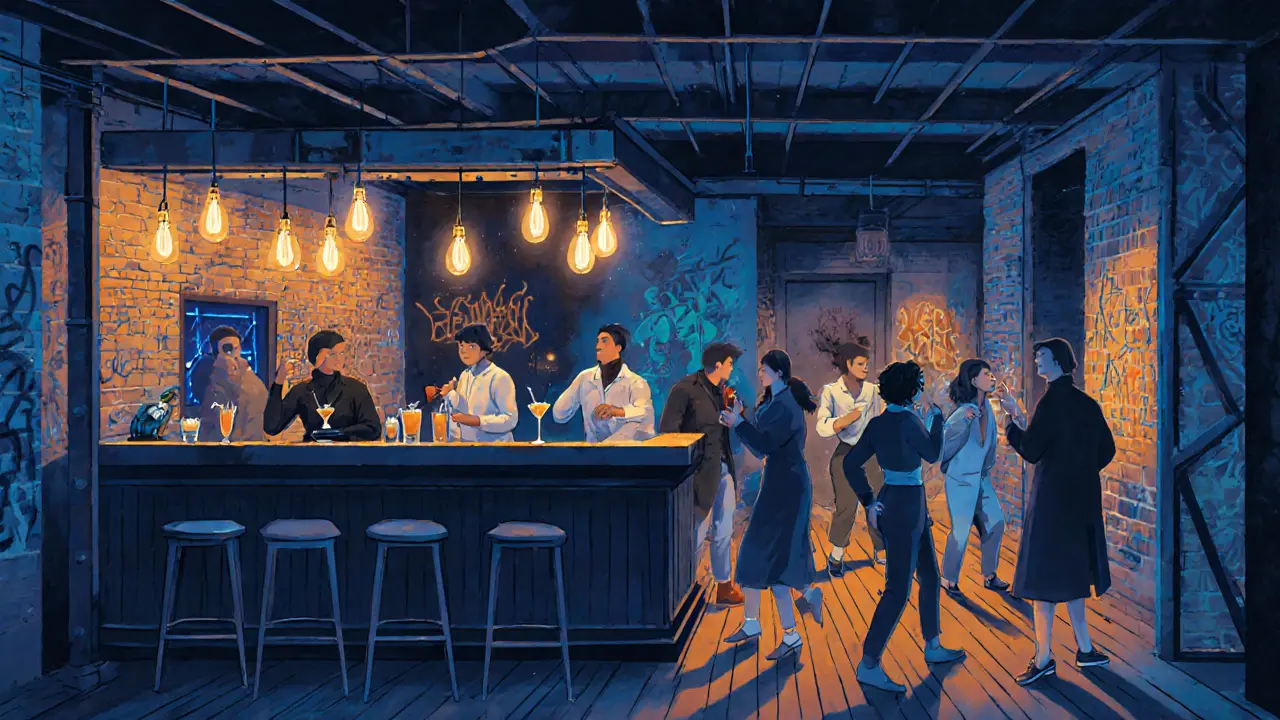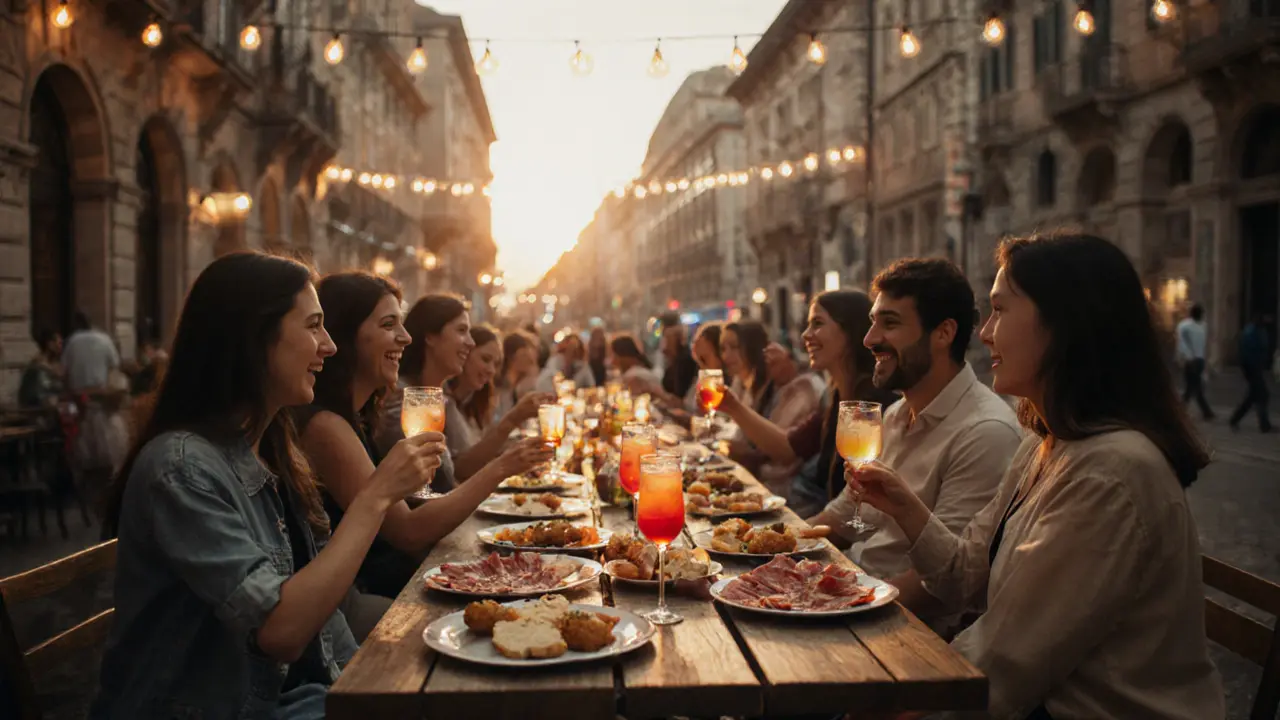When the sun sets over Milan, the city doesn’t sleep-it switches gears. The same streets that buzz with fashion shows by day turn into pulsing corridors of music, cocktails, and laughter by night. This isn’t just about going out. It’s about experiencing a rhythm that’s uniquely Italian, where the night starts late, lasts long, and feels like a slow dance between tradition and rebellion.
Start with the Aperitivo
You haven’t truly experienced Milan until you’ve sat at an outdoor table at dusk with a spritz in hand and a plate of snacks stretching across the table. The aperitivo isn’t a drink-it’s a ritual. Between 7 and 9 p.m., bars across the city swap their daytime quiet for a lively crowd of locals and visitors. For the price of a drink-usually €8 to €15-you get access to a buffet of cold cuts, cheeses, mini paninis, arancini, and sometimes even hot dishes.
Head to Bar Basso in the Porta Nuova district for the original Negroni Sbagliato. Or try La Scala near the opera house, where the crowd is a mix of theater-goers and design students. The trick? Don’t rush. Stay for two hours. That’s when the real magic happens-the conversations deepen, the music turns up just enough, and you realize you’ve made friends with strangers.
Where the Locals Go: Navigating the Neighborhoods
Milan’s nightlife isn’t one-size-fits-all. Each district has its own vibe, and locals know exactly where to be.
Brera is the romantic choice. Cobblestone alleys, vintage bookshops, and intimate wine bars like Il Gatto Nero keep things classy. It’s where couples linger over bottles of Barolo and artists sketch in the corner. No loud music. No crowds. Just slow, smoky evenings.
Isola is the new heartbeat. Once an industrial zone, it’s now Milan’s most creative district. Bars here are raw, industrial-chic, and packed with designers, coders, and musicians. Bar Basso Isola (yes, they opened a second location) and Spazio 56 serve craft cocktails with names like "Carbonara on the Rocks" and play indie electronic beats. This is where the city’s youth gathers to unwind after work.
Porta Ticinese is the wild card. This stretch along the Navigli canals is packed with open-air bars, live music, and outdoor seating. On weekends, the sidewalks turn into dance floors. La Zisa has live jazz on Thursdays, while Bar San Vittore throws themed parties-think 80s night or drag bingo. The energy here is contagious. You don’t plan to dance-you just end up dancing.
Clubs: From Underground to Glamour
Clubbing in Milan isn’t just about bass-it’s about identity. You don’t just pick a club. You pick a scene.
If you want exclusivity, head to La Scala Club inside the Teatro alla Scala. It’s invite-only, but if you know someone who works in fashion or art, you might get in. Inside, it’s velvet curtains, chandeliers, and house music that feels like it’s been mixed by someone who studied at Berklee. The dress code? No sneakers. No hoodies. Think tailored jackets and heels.
For something grittier, go to Magazzini Generali in the Bovisa district. This warehouse-turned-club hosts underground techno nights with international DJs. The crowd is international, the sound system is insane, and the vibe is raw. Doors open at midnight. People don’t leave until 6 a.m. It’s not for everyone-but if you’ve ever wanted to dance in a space that feels like a secret, this is it.
And then there’s Opium, the glittering gem of the nightlife scene. Located near the Duomo, it’s a mix of luxury and hedonism. Think mirrored ceilings, VIP booths, and a DJ spinning disco-house remixes of Italian pop hits. The crowd here is a mix of models, influencers, and wealthy Italians who treat Friday night like a red-carpet event. Cover charge? Around €20. Worth it if you want to see-and be seen.

What to Wear (And What Not To)
Milan is fashion capital for a reason. What you wear matters-even if you’re just grabbing a drink.
At aperitivo spots and wine bars, smart casual is fine. Jeans with a nice shirt or dress? Perfect. But step into a club like Opium or La Scala Club, and you’ll be turned away if you’re wearing sneakers, ripped jeans, or a baseball cap. Men: button-down shirts or blazers. Women: dresses, tailored pants, or elegant tops. No flip-flops. No athletic wear. Ever.
Pro tip: Bring a light jacket. Even in summer, Milan nights get cool near the canals or in open-air venues. And always carry a small bag-big backpacks aren’t allowed in most clubs.
Timing Is Everything
Milan doesn’t follow the clock. It follows its own rhythm.
Aperitivo starts at 7 p.m. Bars fill up by 8:30. Dinner? Most locals eat between 9 and 10 p.m. Clubs don’t get busy until after midnight. The real party starts at 1 a.m. and peaks at 3 a.m. If you show up at 10 p.m. hoping to dance, you’ll be sitting alone. Wait. The city isn’t ready yet.
Also, don’t expect to find a taxi at 4 a.m. unless you’re near a metro station. Use Bolt or Free Now to book rides. The metro shuts down at 1:30 a.m., so plan ahead.

Hidden Gems and Local Secrets
Most guides miss these spots.
Bar del Fico in the Navigli area has a rooftop terrace with string lights and a view of the canal. Order the Aperol Spritz with a side of fried zucchini flowers. It’s quiet, romantic, and rarely crowded.
Al Mercato is a hidden bar inside a converted grocery store in Isola. They serve cocktails made with local herbs and gin distilled in Lombardy. The bartender remembers your name. And your drink.
And if you’re into live music, check out Blue Note Milano. It’s not a club. It’s a jazz sanctuary. No loud beats. Just saxophones, double bass, and silence between notes. You’ll hear musicians from New York, Brazil, and Tokyo. Tickets cost €25, but it’s worth every euro.
What to Avoid
Not every place with a neon sign is worth your time.
Avoid the tourist traps near the Duomo that charge €20 for a watered-down cocktail and play Top 40 hits. These places are loud, overpriced, and empty of real Milanese energy.
Also, don’t expect English to be widely spoken in smaller bars. Learn a few phrases: "Un Aperol, per favore", "Quanto costa?", "Grazie". Locals appreciate the effort.
And never, ever try to haggle on prices. In Milan, the cost of a drink is the cost of a drink. It’s not a market stall. It’s culture.
Final Thoughts: The Real Milan Night
Milan’s nightlife isn’t about checking off clubs. It’s about feeling the pulse of a city that knows how to live. You’ll sip a Negroni in a 1920s bar, dance in a warehouse with strangers who become friends, and end the night eating arancini at 3 a.m. with someone you met an hour ago.
This isn’t a party. It’s a way of life. And if you let it, Milan will teach you how to slow down-even when the music is loud.
What is the best time to start a night out in Milan?
Start with an aperitivo around 7 p.m., then have dinner between 9 and 10 p.m. Clubs don’t get busy until after midnight, and the real energy kicks in around 1 a.m. Don’t rush-Milan’s night moves slowly.
Is Milan nightlife safe at night?
Yes, Milan is generally safe at night, especially in popular areas like Brera, Isola, and Navigli. Stick to well-lit streets, avoid isolated alleys after 2 a.m., and use ride-share apps instead of walking long distances. Pickpocketing is rare, but keep your phone and wallet secure in crowded bars.
Do I need to book tables at Milan bars or clubs?
For aperitivo spots, no-just show up. For popular clubs like Opium or La Scala Club, booking a table in advance is smart, especially on weekends. Some venues let you reserve online through their website or Instagram. Walk-ins are fine midweek, but Friday and Saturday nights fill up fast.
Can I pay with credit cards in Milan nightlife spots?
Most bars and clubs accept cards, especially in tourist areas. But smaller, local spots-especially in Isola or Navigli-often prefer cash. Keep €20-30 in euros on you just in case. ATMs are plentiful, but avoid those inside tourist traps-they charge high fees.
Are there any free nightlife options in Milan?
Yes. Many bars in Isola and Brera offer free live music on weekdays, especially Tuesday and Wednesday nights. The Navigli canals are always open for evening strolls, and you can enjoy the lights and atmosphere without spending a cent. Also, check local event listings-some cultural centers host free jazz nights or film screenings in summer.
